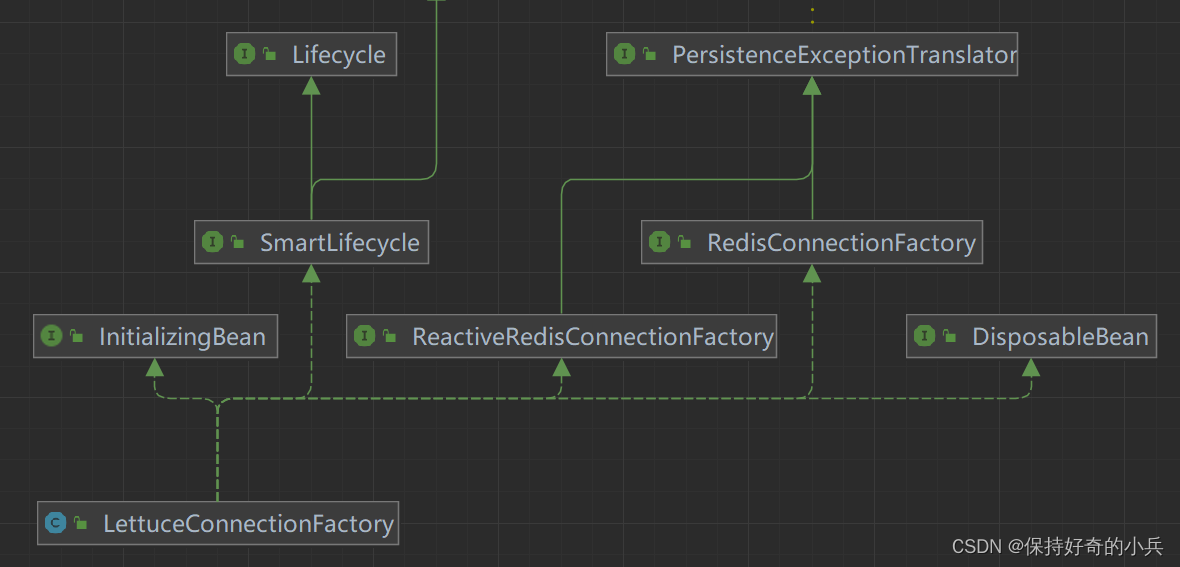简介
Lettuce是一款基于netty构建,支持同步、异步、reactive模式访问,支持连接复用的高性能redis开源客户端。
考虑到集群模式的redis无论性能还是可靠性都明显优于其余模式、笔者也只使用过集群模式,本文主要分析集群模式下的客户端处理流程。
基于spring-data-redis集成lettuce客户端
1、引入依赖:
<dependency>
<groupId>org.springframework.boot</groupId>
<artifactId>spring-boot-starter-data-redis</artifactId>
</dependency>
<dependency>
<groupId>io.lettuce</groupId>
<artifactId>lettuce-core</artifactId>
</dependency>
2、定义redis配置bean:RedisConfiguration
@Bean
public RedisConfiguration redisConfiguration() {
RedisClusterConfiguration redisClusterConfiguration =
new RedisClusterConfiguration(Collections.singleton("redis.server.address:6379"));
redisClusterConfiguration.setUsername("xxx");
redisClusterConfiguration.setPassword("xxx");
return redisClusterConfiguration;
}
3、定义redis连接工厂bean:RedisConnectionFactory
@Bean
public RedisConnectionFactory redisConnectionFactory(RedisConfiguration redisConfiguration) {
LettuceConnectionFactory lettuceConnectionFactory = new LettuceConnectionFactory(redisConfiguration);
// 是否饥饿式初始化,即服务启动时建立redis连接,默认false
lettuceConnectionFactory.setEagerInitialization(false);
// 是否复用底层tcp连接,默认true
lettuceConnectionFactory.setShareNativeConnection(true);
return lettuceConnectionFactory;
}
4、定义RedisTemplate
@Bean
public RedisTemplate<String, String> redisTemplate(RedisConnectionFactory connectionFactory) {
return new StringRedisTemplate(connectionFactory);
}
Lettuce客户端创建和启动流程
LettuceConnectionFactory初始化

LettuceConnectionFactory实现了InitializingBean接口,在创建bean阶段、属性字段设置完成后会回调afterPropertiesSet方法:
最终调用org.springframework.data.redis.connection.lettuce.LettuceConnectionFactory#start
@Override
public void afterPropertiesSet() {
if (isAutoStartup()) {
start();
}
}
LettuceConnectionFactory#start方法主要流程:
主要完成lettuce客户端的构造、并按需初始化tcp连接
public void start() {
// 更新状态为启动中
State current = this.state.getAndUpdate(state -> isCreatedOrStopped(state) ? State.STARTING : state);
// 幂等处理、状态检查
if (isCreatedOrStopped(current)) {
// 构造lettuce客户端
AbstractRedisClient client = createClient();
this.client = client;
// 构造真正的连接工厂
LettuceConnectionProvider connectionProvider = new ExceptionTranslatingConnectionProvider(
createConnectionProvider(client, CODEC));
this.connectionProvider = connectionProvider;
this.reactiveConnectionProvider = new ExceptionTranslatingConnectionProvider(
createConnectionProvider(client, LettuceReactiveRedisConnection.CODEC));
// 如果是集群模式的redis,构造命令执行器
if (isClusterAware()) {
this.clusterCommandExecutor = createClusterCommandExecutor((RedisClusterClient) client, connectionProvider);
}
// 更新状态为已启动
this.state.set(State.STARTED);
// 如果是饥饿式启动且开启连接复用,则初始化tcp连接
if (getEagerInitialization() && getShareNativeConnection()) {
initConnection();
}
}
}
org.springframework.data.redis.connection.lettuce.LettuceConnectionFactory#initConnection方法流程
public void initConnection() {
// 幂等处理,如果已存在连接,则重置旧的连接
resetConnection();
// 根据redis模式获取连接
if (isClusterAware()) {
getSharedClusterConnection();
} else {
getSharedConnection();
}
getSharedReactiveConnection();
}
protected StatefulRedisClusterConnection<byte[], byte[]> getSharedClusterConnection() {
return shareNativeConnection && isClusterAware()
? (StatefulRedisClusterConnection<byte[], byte[]>) getOrCreateSharedConnection().getConnection()
: null;
}
org.springframework.data.redis.connection.lettuce.LettuceConnectionFactory.SharedConnection#getConnection:建立连接并校验连接是否正常
StatefulConnection<E, E> getConnection() {
return doInLock(() -> {
if (this.connection == null) {
this.connection = getNativeConnection();
}
// 校验连接是否正常
if (getValidateConnection()) {
validateConnection();
}
return this.connection;
});
}
getNativeConnection()最终会调用org.springframework.data.redis.connection.lettuce.ClusterConnectionProvider#getConnectionAsync
关键代码如下
public <T extends StatefulConnection<?, ?>> CompletableFuture<T> getConnectionAsync(Class<T> connectionType) {
// 集群topo信息初始化代码
if (!initialized) {
// Partitions have to be initialized before asynchronous usage.
// Needs to happen only once. Initialize eagerly if blocking is not an options.
lock.lock();
try {
if (!initialized) {
client.getPartitions();
initialized = true;
}
} finally {
lock.unlock();
}
}
// pubsub连接建立
if (connectionType.equals(StatefulRedisPubSubConnection.class)
|| connectionType.equals(StatefulRedisClusterPubSubConnection.class)) {
return client.connectPubSubAsync(codec).thenApply(connectionType::cast);
}
// 建立集群连接
if (StatefulRedisClusterConnection.class.isAssignableFrom(connectionType)
|| connectionType.equals(StatefulConnection.class)) {
return client.connectAsync(codec).thenApply(connection -> {
getReadFrom().ifPresent(connection::setReadFrom);
return connectionType.cast(connection);
});
}
String message = String.format("Connection type %s not supported", connectionType);
return LettuceFutureUtils.failed(new InvalidDataAccessApiUsageException(message));
}
集群连接建立最终会调用lettuce客户端方法:io.lettuce.core.cluster.RedisClusterClient#connectClusterAsync
private <K, V> CompletableFuture<StatefulRedisClusterConnection<K, V>> connectClusterAsync(RedisCodec<K, V> codec) {
// 开启topo自动刷新机制
topologyRefreshScheduler.activateTopologyRefreshIfNeeded();
DefaultEndpoint endpoint = new DefaultEndpoint(getClusterClientOptions(), getResources());
RedisChannelWriter writer = endpoint;
if (CommandExpiryWriter.isSupported(getClusterClientOptions())) {
writer = new CommandExpiryWriter(writer, getClusterClientOptions(), getResources());
}
if (CommandListenerWriter.isSupported(getCommandListeners())) {
writer = new CommandListenerWriter(writer, getCommandListeners());
}
ClusterDistributionChannelWriter clusterWriter = new ClusterDistributionChannelWriter(writer, getClusterClientOptions(),
topologyRefreshScheduler);
// 关注PooledClusterConnectionProvider构造方法执行内容,后面会再提到
PooledClusterConnectionProvider<K, V> pooledClusterConnectionProvider = new PooledClusterConnectionProvider<>(this,
clusterWriter, codec, topologyRefreshScheduler);
clusterWriter.setClusterConnectionProvider(pooledClusterConnectionProvider);
StatefulRedisClusterConnectionImpl<K, V> connection = newStatefulRedisClusterConnection(clusterWriter,
pooledClusterConnectionProvider, codec, getFirstUri().getTimeout());
connection.setReadFrom(ReadFrom.UPSTREAM);
connection.setPartitions(partitions);
// 命令处理handler,构造netty客户端时会用到
Supplier<CommandHandler> commandHandlerSupplier = () -> new CommandHandler(getClusterClientOptions(), getResources(),
endpoint);
Mono<SocketAddress> socketAddressSupplier = getSocketAddressSupplier(connection::getPartitions,
TopologyComparators::sortByClientCount);
// 建立连接,最终调用io.lettuce.core.cluster.RedisClusterClient#connectStatefulAsync
Mono<StatefulRedisClusterConnectionImpl<K, V>> connectionMono = Mono
.defer(() -> connect(socketAddressSupplier, endpoint, connection, commandHandlerSupplier));
// 连接重试
for (int i = 1; i < getConnectionAttempts(); i++) {
connectionMono = connectionMono
.onErrorResume(t -> connect(socketAddressSupplier, endpoint, connection, commandHandlerSupplier));
}
// 注册连接关闭回调
return connectionMono.doOnNext(
c -> connection.registerCloseables(closeableResources, clusterWriter, pooledClusterConnectionProvider))
.map(it -> (StatefulRedisClusterConnection<K, V>) it).toFuture();
}
io.lettuce.core.cluster.RedisClusterClient#connectStatefulAsync方法:
private <K, V, T extends StatefulRedisClusterConnectionImpl<K, V>, S> ConnectionFuture<S> connectStatefulAsync(T connection,
DefaultEndpoint endpoint, RedisURI connectionSettings, Mono<SocketAddress> socketAddressSupplier,
Supplier<CommandHandler> commandHandlerSupplier) {
// 创建连接构造器
ConnectionBuilder connectionBuilder = createConnectionBuilder(connection, connection.getConnectionState(), endpoint,
connectionSettings, socketAddressSupplier, commandHandlerSupplier);
// 初始化channel
ConnectionFuture<RedisChannelHandler<K, V>> future = initializeChannelAsync(connectionBuilder);
return future.thenApply(channelHandler -> (S) connection);
}
initializeChannelAsync方法最终调用io.lettuce.core.AbstractRedisClient#initializeChannelAsync0,关键代码如下:
private void initializeChannelAsync0(ConnectionBuilder connectionBuilder, CompletableFuture<Channel> channelReadyFuture,
SocketAddress redisAddress) {
// netty客户端启动引导,在前文createConnectionBuilder流程中构造
Bootstrap redisBootstrap = connectionBuilder.bootstrap();
// 连接初始化器
ChannelInitializer<Channel> initializer = connectionBuilder.build(redisAddress);
redisBootstrap.handler(initializer);
clientResources.nettyCustomizer().afterBootstrapInitialized(redisBootstrap);
// 建链
ChannelFuture connectFuture = redisBootstrap.connect(redisAddress);
channelReadyFuture.whenComplete((c, t) -> {
if (t instanceof CancellationException) {
connectFuture.cancel(true);
}
});
// 建链响应回调处理,连接初始化、握手结果处理
connectFuture.addListener(future -> {
// 省略。。。
});
}
channel初始化器构造:io.lettuce.core.ConnectionBuilder#build
public ChannelInitializer<Channel> build(SocketAddress socketAddress) {
return new PlainChannelInitializer(this::buildHandlers, clientResources);
}
protected List<ChannelHandler> buildHandlers() {
List<ChannelHandler> handlers = new ArrayList<>();
connection.setOptions(clientOptions);
// channel连接、断链事件监听handler(tcp级别事件)
handlers.add(new ChannelGroupListener(channelGroup, clientResources.eventBus()));
// resp协议编码handler
handlers.add(new CommandEncoder());
// 连接建立后握手handler,主要执行AUTH、PING命令
handlers.add(getHandshakeHandler());
// 命令处理handler
handlers.add(commandHandlerSupplier.get());
// 连接事件发布handler(握手完成后,应用层级别的事件)
handlers.add(new ConnectionEventTrigger(connectionEvents, connection, clientResources.eventBus()));
// 自动重连处理handler
if (clientOptions.isAutoReconnect()) {
handlers.add(createConnectionWatchdog());
}
return handlers;
}
以上就是LettuceConnectionFactory在bean创建后初始化lettuce集群客户端、饥饿式初始化连接的流程;
懒惰式建链是由第一次命令执行时触发建链,建链调用触发点为org.springframework.data.redis.core.RedisTemplate#execute(org.springframework.data.redis.core.RedisCallback, boolean, boolean),实际原理与饥饿式建链一致,此处不再赘述。
总结:
spring应用启动时,会回调LettuceConnectionFactory#afterPropertiesSet方法,实现构造lettuce客户端、并在饥饿式建链时初始化netty客户端、建链,执行resp协议握手流程。
Lettuce客户端redis命令处理流程见—Lettuce源码详解(二)
注:本文基于个人理解编写,如有不当之处欢迎指正
参考内容:
https://github.com/spring-projects/spring-data-redis
https://github.com/redis/lettuce






















 4209
4209

 被折叠的 条评论
为什么被折叠?
被折叠的 条评论
为什么被折叠?








